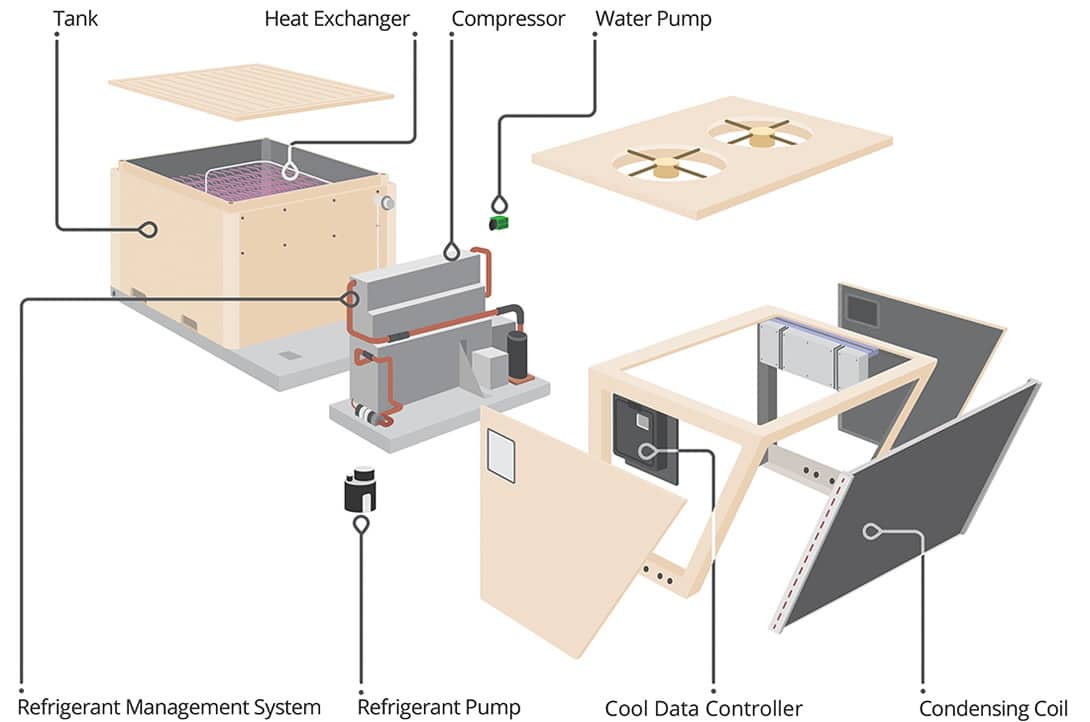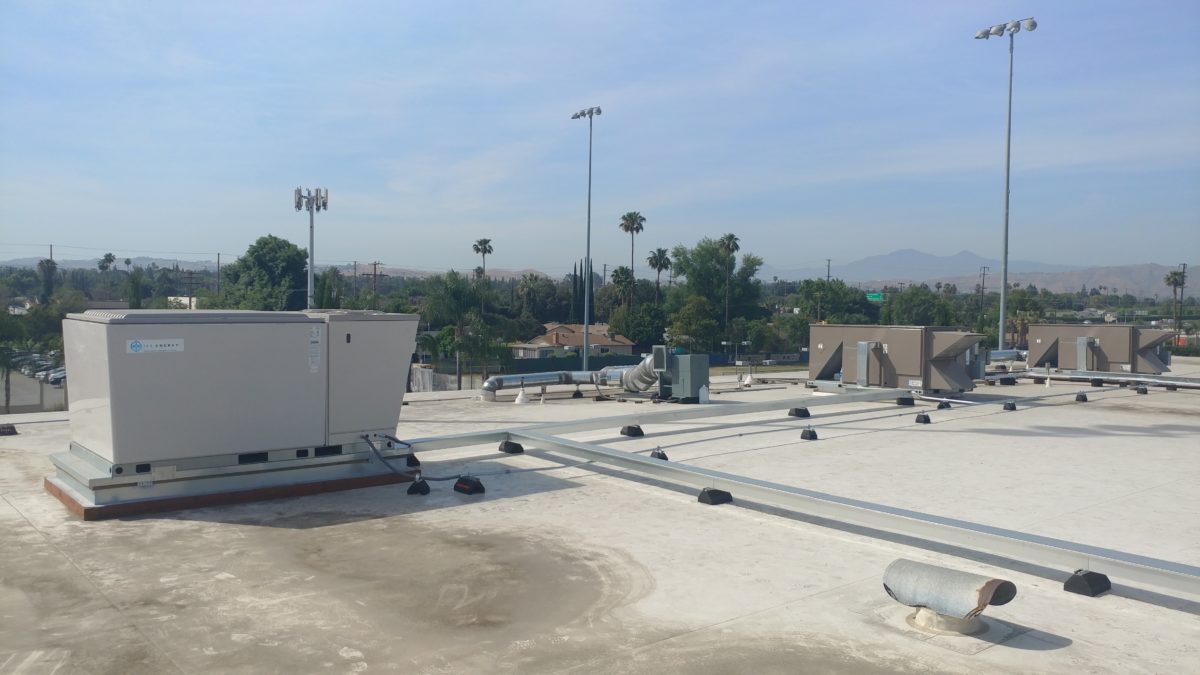In nearly all regions of the United States, peak annual electricity demand comes in the afternoon on the hottest days of the year, when air conditioners in homes and offices are cranked to the maximum. It’s one of the main technical challenges for utilities and grid operators, which must sign contracts with power plants to ensure that they have sufficient capacity on hand to meet only a few hours of demand, and it can be hard to predict just how much they will need.
In Southern California, one company has come up with a solution to marry peak electric demand with cheap overnight electricity prices. And in a field where interconnected software and high-tech chemical batteries dominate, their solution is both simple and oddly tangible: making ice.
Earlier this month Ice Energy completed the first phase of a project to deploy over 1,200 ice-making and cooling machines at businesses and industrial facilities across the territory of utility Southern California Edison (SCE).
And while there have been larger single-site thermal storage projects, such as the molten salt system at the 300 MW Solana Concentrating Solar Power (CSP) plant in Arizona, Ice Energy says that when complete this will be the largest distributed thermal energy storage system in the nation.
Ice “batteries”
The core of Ice Energy’s project is the Ice Bear, a unit that is typically sited on the roof of commercial and industrial buildings along with an air conditioner. The Ice Bear makes ice by drawing electricity at times that electricity prices are low, which is often overnight, and then takes over from the air conditioner when prices and electricity demand are high.
The system has many of the features of standard cooling systems, including a condensing coil, pumps and a heat exchanger. In addition there is a tank to store the water and ice. But it also has data controllers to provide intelligence regarding electricity prices, similar to batteries. As such, the system is something of an air conditioning and energy storage hybrid.

Ice Energy describes its system as a thermal battery, and like batteries the company articulates the scale of its units in watt and watt-hour terms. In the first phase of the SCE project, Ice Energy deployed 100 units, which it says represents 1.9 MW; the full project for SCE will be 21.6 MW in around 1,200 systems. As the company estimates the equivalent of a six-hour rating, this would be around 130 megawatt-hours for the whole project.
Ice Energy also estimates that its units come at half the life-cycle cost of lithium-ion batteries, and key to understanding this is that the company calculates a 20-year life for its products, which is longer than most lithium-ion batteries.
Utility partnerships
Under the terms of its arrangement with SCE, Ice Energy supplies and installs its units at businesses and industrial facilities free of charge to property and business owners. To pay for the units the company holds contracts with SCE to manage peak demand and load shifting, under which SCE will be able to operate the units as it sees fit to meet system needs.
There is the potential here to assist in the integration of higher levels of renewable energy as well. While the output of California’s vast quantities of solar PV somewhat coincide with peak demand, like in other areas this overlap is not perfect, as the peak of air conditioning use tends to come later in the day than the peak of solar output. Furthermore Ice Bear and other thermal energy solutions can help to mitigate air conditioning demand after the sun goes down, and without some form of energy storage solar PV on its own can not.
This is not the first deployment of Ice Bear in partnership with a utility; the municipal utility in the City of Glendale, California has installed at least 162 Ice Bear units in its service area. Furthermore, Ice Energy has a 5 MW contract with a municipal utility in the City of Riverside, as well as a 1 MW contract with the island of Nantucket in Massachusetts and a 500 kW contract with utility Eversource.
In terms of private installations, the units are deployed in a total of 13 U.S. states, as well as in the UK, Denmark, Saudi Arabia and Singapore.
Ice Bear population growth
Ice Energy notes that not every utility service area is ideal for its products. The company notes that utility rates must align with its ability to deliver peak demand reduction, and that energy storage options must be either accepted by utilities or mandated, such as in California. The company further notes that when partnering with utilities, customers sometimes have difficulty understanding that the technology comes with no cost to them.
But for the markets that can benefit from its technology, Ice Energy notes that it does not have any barriers to scaling its output, noting that its products do not depend upon rare earth materials or other hard-to-find components.
Furthermore, Ice Energy notes that it is poised to benefit from the potential payment for ancillary services under FERC Order 841, which requires utilities to create market structures that allow energy storage devices to participate.
As is the case with all technologies, it remains to be seen what Ice Energy’s future will bring. The United States will need to deploy a truly massive volume of energy storage to rapidly decarbonize its electricity supply using renewable energy, and Ice Bear could be part of this solution.
This content is protected by copyright and may not be reused. If you want to cooperate with us and would like to reuse some of our content, please contact: editors@pv-magazine.com.









They must have an abundance of customers. I have sent them 3 emails through their website over the course of a year inquiring about their system for my condo building and all 3 have been ignored.
The total energy consumption for an ice thermal storage system will be much higher than without storage due to losses which are much higher than with battery storage (based on studies I found a while ago – unfortunately I didn’t save the links), so even with zero installation cost, it only makes economic sense for the homeowner when either there is a large cost difference by time of day in the time of use rate structure or if the home or building has an oversized PV system in a location where net metering is at much less than retail (or there is no net metering). It can be useful to help reduce the amplitude of the duck curve, which may make the increase in energy consumption a worthwhile tradeoff, just saying there is a tradeoff, it isn’t a free load shift.
Thank you for that insight. I didn’t get detailed information on round-trip efficiency of making ice from Ice Energy (I’m not sure they understood my question), and so I’d welcome any study that shows how much energy is lost in the process of making and melting ice.
vacuum panels using aero-gels – problem solved with respect to heat loss (or in this case – heat gain)
I am confused as to how the ice thermal storage helps to de-carbonize our electrical generation industry. The ice is produced at night during off-peak hours using time of day, reduced cost electrical power generated by…..in the vast majority of utilities none other than fossil fuel based generation (exception would be nuclear). All this is doing is reduce peak demand – load shaping – to allow the utility to possibly avoid dispatching peaking generation stations (most likely natural gas generators). Both are fossil fuel sources of power generation so the net carbon reduction without consideration of efficiency and losses is zero. When you factor in the kW / ton of cooling required for creating ice versus conventional air conditioning, the power consumption is 10-25% higher plus standby losses it is easy to justify that the ice storage concept is carbon negative! The only strategy that would benefit carbon reduction would be to generate the ice during the day using surplus PV generated power. With this strategy, they might want to consider dedicated PV panels to allow the fully charged ice module to be maintained (ie; compensate for standby losses) using dedicate PV…..ideally with a DC driven refrigeration compressor! Once discharged, the unit would not be able to be used again till the following day due to its need to recharge the following day from clean renewable energy. This operating strategy would require double the ice units – to allow for alternating days of discharging and charging.
You can make ice whenever you want; you typically do it when power is cheap. Land-based wind tends to produce a fair amount overnight, so in grids with a lot of wind, you do it when wind is producing. You could also make ice in the morning with PV and then use it for AC when it gets hot in the afternoon.
Anything that consumes power on a flexible basis and reduces demand at other times in an efficient process is useful for integrating more renewables. Demand-side flexibility may end up being the key to getting us to very high penetrations of wind and solar without massive battery and other storage.
Your point about round-trip efficiency is interesting and relevant. The answers I got from Ice Energy on that weren’t really useful, and I’m still looking for a neutral source on how much power gets lost in the transaction.
Your point of wind power being available at night is valid for areas with wind. I do not believe this to be case for SCE though. Typically ice builders take a relatively long period to become fully charged 6 – 10 hours; for water on tube type ice builders. When you factor this in to the operating strategy your comment about using PV power generation in the morning to charge the ice would not yield a fully charged unit.
Thermal storage is not a new concept. It was very big in the late 80’s and early to mid 90’s. driven by utility incentive programs and special time of day tariffs. Using thermal storage as a means of reducing carbon emissions is possible; however, there are many issues to consider that impact the operational strategy. The history of ice storage is not a rosy one. Optimal charging and discharging of the ice builders can be problematic resulting in the net cooling effect being de-rated and negatively impacting energy efficiency.
Thanks for that clarification on the 6-10 hours; I wasn’t aware of that and that would be a significant factor.
So for this to be a solution for integrating more renewables I suppose there has to be enough wind.
The article makes for an interesting read, since I did not know much about the usage of ice-making and cooling machines in this manner. With North America consuming a lot of electricity due to air conditioning, and the number of air-conditioning units in the region to reach more than 50 million units by 2020, it seems like a brilliant solution. Again, I do want to properly know the numbers associated with this system.